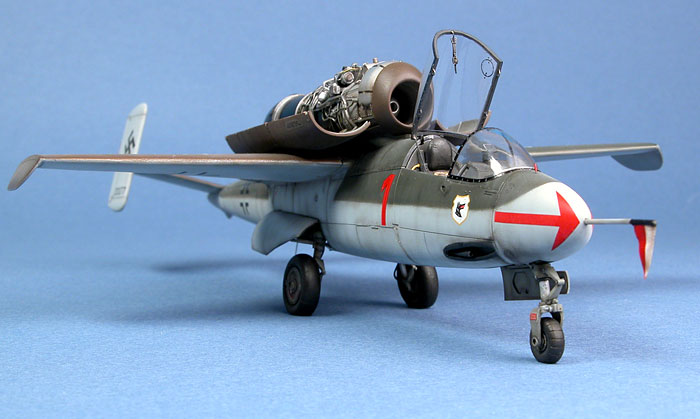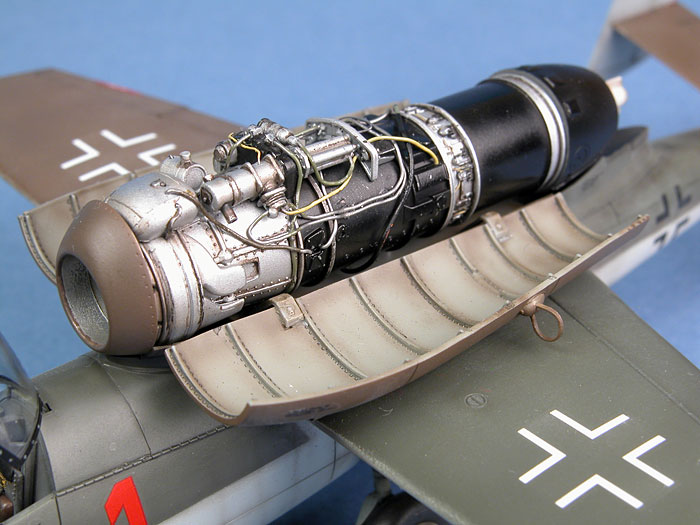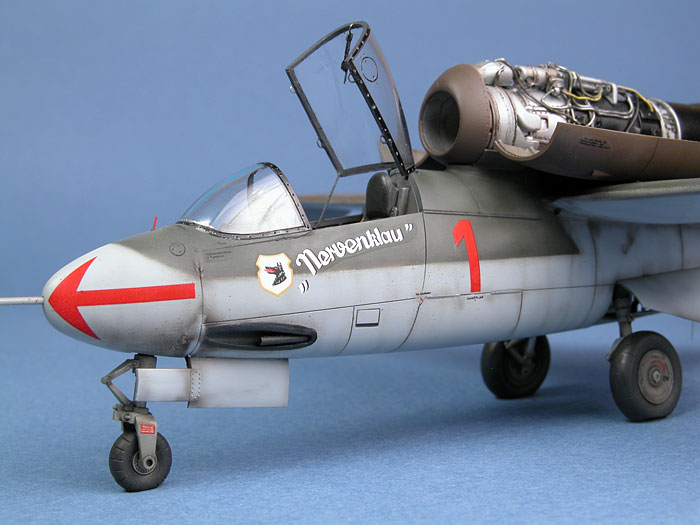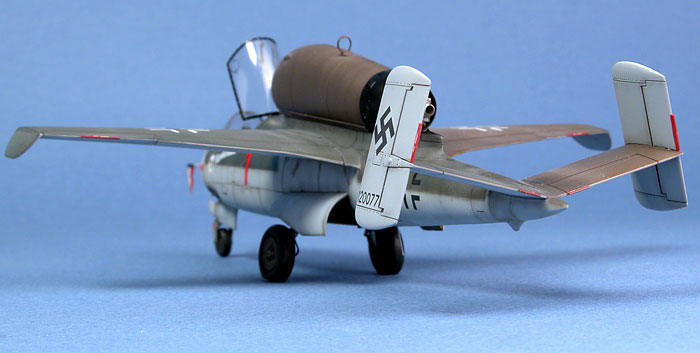|
Tamiya's 1/48 scale
Heinkel He 162 A-2
by Chris Wauchop
|

|
|
Heinkel He 162 A-2 |
images by Brett Green

Tamiya's 1/48 scale Heinkel He 162A-2 is available online
from Squadron.com
Here is my Tamiya 1/48 scale Heinkel He 162.
This is the second Volksjager that I have finished in the last year
or so. During 2005
I built Revell's 1/32 scale He 162, but I must say that I prefer the
shape, detail and parts breakdown of the smaller scale Tamiya kit.

In the Box
Tamiya's 1/48 scale Heinkel He 162A-2 comprises
113 parts in grey plastic; 4 parts in clear; poly caps; metal nose
weight and markings for four aircraft.
The parts are beautifully moulded in classic
Tamiya style. Panel lines are crisply recessed on the fuselage and on
control surface hinge lines. These may be a little heavy for some
tastes, but Tamiya has correctly avoided panel detail on the wooden
surfaces of the airframe. There are no moulding flaws on my sample, but
ejector pin circles are visible in a number of areas that will be on
display when the model is finished (albeit not on prominent
display) such as the interior of the gear doors, the fuselage sidewalls
and inside the engine cowls.
The cockpit and wheel wells are nicely detailed
while enjoying a small parts count.
Click
the thumbnails below to view larger images:
Engineering of the kit is geared towards ease of
assembly, and features some welcome aids to the modeller including a
metal nose weight behind the cockpit and a central wing spar installed
between the fuselage halves. This spar also mounts the engine via two
metal rivets.
Tamiya supplies a simple but quite effective BMW 003
turbojet engine. This may be displayed inside the open engine nacelle on
the aircraft, or separately on an engine dolly. A third option is also
possible, although it is not specifically mentioned in the instructions.
Enough parts are supplied to build both an open engine nacelle and
a closed engine nacelle, each complete with engine cowls. As the engine
nacelle is mounted using poly caps, the open and closed nacelles can be
swapped out after construction depending on whether you want to display
the engine or not.
The main undercarriage doors are moulded shut on a
single lower fuselage centre section that will have to be sliced into
three separate parts. This is not difficult surgery by any means, but it
is peculiarly uncharacteristic for a Tamiya kit.
Canopy parts are perfectly clear. The opening section is
moulded separately so that the canopy can be displayed open. The
windscreen is moulded to a section of fuselage to reduce the chances of
smudging that nice shiny plastic.
I was asked to build this model with the engine cowl
closed, and not to worry about the kit-supplied BMW 003 engine. However,
I couldn't resist when Brett pointed out that I could interchange closed
and open cowls to display the engine in both configurations on the one
model. I therefore added most of the plumbing detail using various
gauges of fine wire, with the help of reference photos in Issue 175 of
the French model magazine, Replic.

Otherwise, construction was very fast and
straightforward, but I did make a few minor changes and additions. These
included:
-
Brake lines on the main
undercarriage legs from fine soldering wire.
-
Tyres slightly
flattened.
-
FuG 25a antenna added
using fine brass wire.
-
Pitot tube warning flag
from Tamiya masking tape.
-
Rudder pedal straps from
lead foil.
-
Seat belts made from
lead foil. Buckles from fine wire.
-
Wiring in cockpit from
fine unravelled picture hanging cable.

-
Ejector seat handles
(strangely missing from the kit seat) added from 24 gauge copper
wire.
-
Rear canopy locking
loops from fine wire.
-
Open canopy support rod
from fine brass wire.
-
Small scoop opened on
engine cowl.
-
Landing gear added from
fine brass wire.
-
Canopy locking handle
was sourced from left-over photo-etched parts combined with fine
wire.
The model was painted using my metal-bodied Aztek A470
airbrush fitted with the "Fine" tan-coloured tip.
The cockpit interior was painted Tamiya XF-24 Dark Grey.
The canopy frame was painted using Tamiya XF-63 German Grey, with light
grey spots representing rivets. The round ventilation hatch in the
canopy was painted using a fine brush.

The undercarriage and wheel wells were painted
Gunze-Sangyo H70 RLM 02 Grey.
Lower surfaces were painted with Gunze H417 RLM 76 Light
Blue.
Upper surfaces were painted with Gunze H421 Brown Violet
with a drop or two of Tamiya XF-64 Red Brown, and H423 RLM 83 Dark
Green.
Weathering was applied using my usual method, spraying a
thin mix of Black and Red Brown along panel lines and in the occasional
random streak, with a thin wash completing this post-shading.

References
Click the thumbnails below to view larger images:
Model by Chris Wauchop
Text Copyright © 2006 by Chris Wauchop & Brett Green
Images Copyright © 2006 by
Brett Green
Page Created 14 August, 2006
Last Updated 21 February, 2007
Back to HyperScale
Main Page
|
Home
| What's New |
Features |
Gallery |
Reviews |
Reference |
Forum |
Search